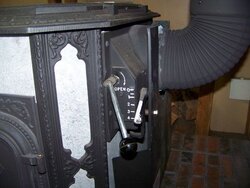House was cold and it started to snow around 10 AM. So about an hour ago I loaded up the (warm, coals) stove with 4 good sized splits and a biobrick to get things going. Well it took off pretty well so I engaged the cat and left the air open to get the heat out into the room. Noticed it looked like a "roaring" blaze a few minutes ago and the stovetop is a bit over 600 and climbing. I can hear the "metal adjustment" noises like a car after you turn it off. I cut the air back to half and it's still rolling along.
If I cut the air all the way, the top will get hotter, yeah? So how do I get it to slow down a bit?
My main worry is that it's early dismissal today, I have to go pick up at school in 20 minutes and don't want to leave the stove in an empty house like this. I thought loading at 11 ish would give me plenty of time before leaving at 12:40 or so.
Help?
Mary
If I cut the air all the way, the top will get hotter, yeah? So how do I get it to slow down a bit?
My main worry is that it's early dismissal today, I have to go pick up at school in 20 minutes and don't want to leave the stove in an empty house like this. I thought loading at 11 ish would give me plenty of time before leaving at 12:40 or so.
Help?
Mary



 Next time I'll not reload within...2 hours? of leaving the house...
Next time I'll not reload within...2 hours? of leaving the house...
